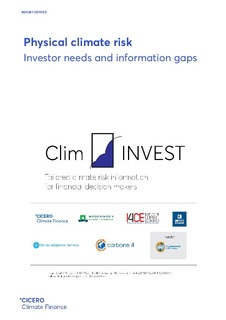| dc.contributor.author | Bruin, Karianne de | |
| dc.contributor.author | Romain, Hubert | |
| dc.contributor.author | Evain, Julie | |
| dc.contributor.author | Clapp, Christa | |
| dc.contributor.author | Dahl, Miriam Stackpole | |
| dc.contributor.author | Bolt, Jaclyn | |
| dc.date.accessioned | 2019-03-11T09:09:12Z | |
| dc.date.available | 2019-03-11T09:09:12Z | |
| dc.date.issued | 2019-03-11 | |
| dc.identifier.issn | 0804-4562 | |
| dc.identifier.uri | http://hdl.handle.net/11250/2589503 | |
| dc.description.abstract | While investors are paying more attention to climate change, there is a lack of granular data designed to support financial decisions. Climate science can provide improved indicators and metrics to help investors better manage physical climate risks. This report presents the first results of the ERA4CS-JPI Climate project ClimINVEST aimed at co-designing tailored information on climate change. We provide an overview of investors’ needs and information gaps regarding the physical impacts of climate change. We identify the information sources that financial actors rely on and the challenges they face in decision-making incorporating available climate change information while taking into account diverse investor mandates and risk management approaches. The user needs identified underscore the need for collaborative efforts between researchers and the financial sector on improving climate risk information.
The report presents three geographical case studies – France, the Netherlands and Norway. These countries are at the forefront of creating awareness and acting on the risks and opportunities of the physical impacts of climate change in the financial sector. The cases provide unique perspectives on the country-specific contexts and initiatives related to physical climate risk and user needs, featuring both commonalities and differences.
In France, the 2015’s Energy Transition for Green Growth Act (Article 173-VI) requires institutional investors to report on their integration of climate-related risks in their investment policies. In the Netherlands, the Dutch Central Bank and financial institutions are challenged to deal with potential flood risks from more frequent precipitation and sea level rise. In Norway, actors such as Finance Norway and the Norwegian government are assessing the risks from physical impacts of climate change on the Norwegian economy | nb_NO |
| dc.language.iso | eng | nb_NO |
| dc.publisher | CICERO Center for International Climate and Environmental Research - Oslo | nb_NO |
| dc.relation.ispartof | CICERO Report | |
| dc.relation.ispartofseries | CICERO Report;2019:03 | |
| dc.subject | Financial sector | nb_NO |
| dc.subject | Investor needs | nb_NO |
| dc.subject | Physical Climate Risk | nb_NO |
| dc.subject | Climate Services | nb_NO |
| dc.subject | France | nb_NO |
| dc.subject | The Nederlands | nb_NO |
| dc.subject | Norway | nb_NO |
| dc.title | Physical climate risk: Investor needs and information gaps | nb_NO |
| dc.type | Report | nb_NO |
| dc.description.version | publishedVersion | nb_NO |
| dc.subject.nsi | VDP::Technology: 500 | nb_NO |
| dc.identifier.cristin | 1683669 | |
| dc.relation.project | ClimINVEST, a part of ERA4CS, an ERA-NET initiated by JPI Climate | nb_NO |
